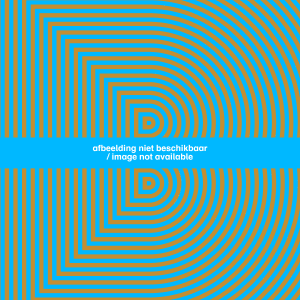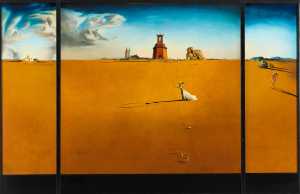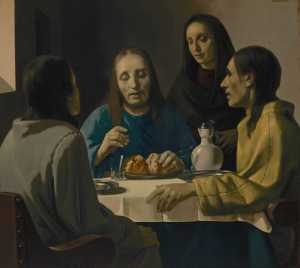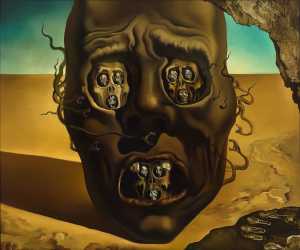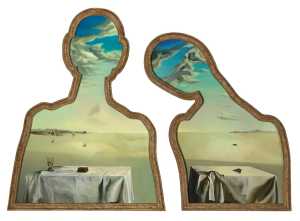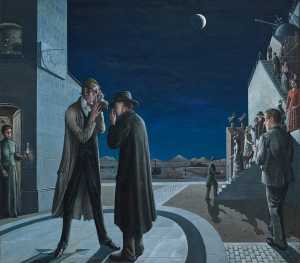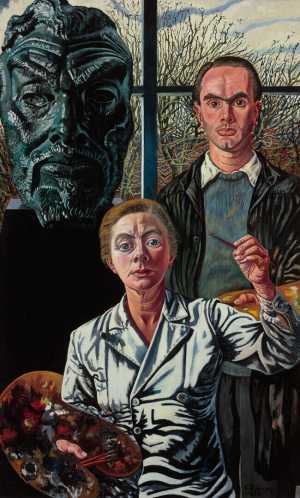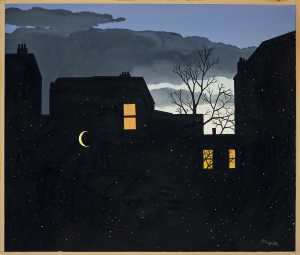Dalí often took the motifs in his paintings from everyday reality. The elegant table in this painting came from a café in Cadaqués, the Catalan fishing village near his birth place Figueras that Dalí kept visiting regularly as an adult. When he was working on this painting he had similar tiles to those depicted laid in his kitchen.

Specifications
| Title | Table solaire |
|---|---|
| Material and technique | Oil on panel |
| Object type |
Painting
> Painting
> Two-dimensional object
> Art object
|
| Location | This object is in storage |
| Dimensions |
Width 46 cm Height 60 cm |
|---|---|
| Artists |
Artist:
Salvador Dalí
|
| Accession number | 2938 (MK) |
| Credits | Purchased 1977 |
| Department | Modern Art |
| Acquisition date | 1977 |
| Creation date | in 1936 |
| Collector | Collector / Edward James |
| Entitled parties | © Salvador Dalí, Fundación Gala-Salvador Dalí, c/o Pictoright Amsterdam 2022 |
| Provenance | Alex Reid and Lefevre Gallery, London 1936; Edward James, Chichester 1936-64; Edward James Foundation, Chichester 1964-77; on loan to Brighton Museum and Art Gallery 1966-77 |
| Exhibitions | London 1936b; New York 1936; Rotterdam 1970-71; Paris 1979; Barcelona/Madrid 1983; Stuttgart/Zurich/Humlebaek 1989-90; Brighton 1998; Barcelona/Madrid/St Petersburg 2004-05; Milan 2010-11; Rotterdam 2011; Paris/Madrid 2012-13; Rotterdam 2013-14a; Edinburgh/Hamburg/Rotterdam 2016-17 |
| Internal exhibitions |
The Collection Enriched (2011) Een paraplu, een naaimachine en een ontleedtafel. Surrealisme à la Dalí in Rotterdam. (2013) Gek van surrealisme (2017) De collectie als tijdmachine (2017) |
| External exhibitions |
Dalí (2012) Dalí, Ernst, Miró, Magritte... (2016) Surreal Encounters - Collecting the Marvellous (2016) Surrealist Art - Masterpieces from Museum Boijmans Van Beuningen (2021) A Surreal Shock – Masterpieces from Museum Boijmans Van Beuningen (2021) A Surreal Shock. Masterpieces from Museum Boijmans Van Beuningen (2023) Dal nulla al sogno (2018) Dalí, Magritte, Man Ray and Surrealism. Highlights from Museum Boijmans Van Beuningen (2023) Only the Marvelous is Beautiful (2022) |
| Research |
Show research A dream collection - Surrealism in Museum Boijmans Van Beuningen |
| Literature | Rotterdam 1970, cat. no. 44; Paris 1979, pp. 298-99; Descharnes 1984, p. 193; Stuttgart/Zurich 1989, p. 187, cat. no. 144; Descharnes/Néret 1994, p. 271; Descharnes 1997, p. 193; Barcelona/Madrid/St Petersburg 2004-05, fig. 8, p. 63; Figueres 2004-present, cat. no. 425; Rotterdam/Barcelona/Madrid 2005, p. 83; Milan 2010-11, pp. 158-59; Paris/Madrid 2012-13, p. 195; Edinburgh 2016, pp. 197, 215, 246, cat. no. 40 |
| Material | |
| Object | |
| Geographical origin | Spain > Southern Europe > Europe |
Entry catalogue A dream collection - Surrealism in Museum Boijmans Van Beuningen
Author: Marijke Peyser

When Museum Boijmans Van Beuningen purchased Salvador Dalí’s Table solaire from the British collector Edward James in 1977, the museum already owned three of Dalí’s works: the gouache Shirley Temple, le plus jeune monstre sacré du cinéma de son temps, the painting Le visage de la guerre, and the sculpture Vénus de Milo aux tiroirs. Table solaire was acquired along with a number of other Surrealist works, including Dalí’s Landscape with a Girl Skipping Rope.
Table solaire is one of the series of paintings made between 1935 and 1936 that depict the coastal area around the Spanish seaside resort of Rosas. These ‘white paintings’ may refer to Dalí’s youth.[1] The table with glasses, for example, can be linked to the El Casino café in Cadaqués, where Dalí regularly stayed.[2]
The figures and objects in these white paintings emerge as if from nothing, as in a mirage. Artistically Table solaire is one of the highlights of Dalí’s work from the 1930s. It is a splendid example of utensils that are placed outside their everyday environment in a strange world and consequently make an impression as new as it is unexpected. While Dalí was working on Table solaire a tiled floor was being laid in the kitchen of his house in Port Lligat, and the painter reproduced it faithfully on the canvas. The camel in the background is the imperturbable ‘carrier’ of two figures. The rider is also portrayed in a number of other works Dalí was working on in 1936. The same man is shown standing in his Pharmacien d’Ampurdan ne cherchant absolument rien (1936). The bust on the camel’s head represents the artist’s father and first appeared in Dalí’s work after the rift with his father in the early 1930s.[3] The related imagery of the camel and the pack of Camel cigarettes lying at the boy’s feet is striking. Dalí later referred to an article by Martin Gardner in the Mathematical Games column of the magazine Scientific American, in which Gardner explained how there were remarkable coincidences on the wrapping of the Camel packet.[4] One example is the word ‘Choice’ on the side of the pack, which remains legible when seen in a mirror. The artist maintained that he had already had a premonition of these discoveries more than thirty years earlier and this is why he depicted the pack of Camel cigarettes in this work.
Footnotes
[1] For the term ‘white paintings’, see Stuttgart/Zurich 1989, p. 185.
[2] Ibid., p. 187.
[3] Dalí’s father strongly disapproved of the love affair that Dalí began with Gala in 1929 – she was ten years his senior and still married to Paul Éluard. He barred his son from the parental home.
[4] Rotterdam 1970, cat. no. 44.
All about the artist
Salvador Dalí
Figueras 1904 - Figueras 1989
Salvador Dali got to know the author André Breton - the founder of the surrealist movement - while he was studying in Madrid. In 1924, Breton wrote the first...
Bekijk het volledige profiel







